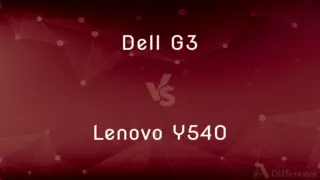RB67 vs. RZ67 — What's the Difference?
By Tayyaba Rehman — Published on January 18, 2024
The RB67 is a fully mechanical medium format camera, while the RZ67 features electronic components and a lighter build.

Difference Between RB67 and RZ67
Table of Contents
ADVERTISEMENT
Key Differences
The RB67, introduced by Mamiya in the late 1960s, is a fully mechanical medium format camera renowned for its robust build and exceptional image quality. The RZ67, introduced later, in 1982, is its successor with several improvements, including electronic components that offer additional functionalities such as auto exposure.
A key feature of the RB67 is its rotating back, which allows for easy switching between landscape and portrait orientations without moving the camera. The RZ67 retains this feature but adds a lighter body and more sophisticated mechanics, enhancing its usability and versatility.
The RB67 operates entirely mechanically, requiring manual operation for all functions, which appeals to traditional photographers who prefer a hands-on approach. The RZ67, while still manual focus, incorporates electronic elements, making it somewhat easier to use and offering more advanced features.
Lens compatibility between the two models differs; the RB67 uses RB lenses, and the RZ67 uses RZ lenses, which are not cross-compatible due to the electronic interface in the RZ67. However, the RZ67 offers more lens choices, including some with leaf shutters.
In summary, the RB67 is admired for its mechanical reliability and simplicity, ideal for purists, while the RZ67 provides a blend of mechanical and electronic features, offering a more modern approach to medium format photography.
ADVERTISEMENT
Comparison Chart
Introduction Year
Late 1960s
1982
Camera Type
Fully mechanical medium format
Mechanical with electronic components
Key Features
Rotating back, manual operation
Lighter build, auto exposure, rotating back
Lens Compatibility
RB lenses only
RZ lenses, including leaf shutter options
Preferred by
Traditional photographers, mechanical purists
Photographers seeking a blend of old and new
Compare with Definitions
RB67
Known for its rotating back and robust build.
The RB67's rotating back made portrait shoots more convenient.
RZ67
Uses RZ lenses, including options with leaf shutters.
I prefer using RZ lenses with leaf shutters for their speed and reliability.
RB67
Launched in the late 1960s by Mamiya.
The RB67 has been a reliable tool since its introduction in the 60s.
RZ67
Introduced by Mamiya in 1982.
The RZ67 has been a favorite among medium format photographers since the 80s.
RB67
Requires manual operation for all functions.
Shooting with the RB67 taught me the fundamentals of manual photography.
RZ67
Features a lighter build compared to its predecessor.
The RZ67's lighter design makes it easier for on-location shoots.
RB67
A fully mechanical medium format camera.
The photographer used the RB67 for its mechanical precision.
RZ67
Offers advanced features like auto exposure.
The auto exposure feature on the RZ67 saves time in dynamic lighting conditions.
RB67
Popular among traditional film photographers.
Many film enthusiasts prefer the RB67 for its classic operation style.
RZ67
A medium format camera combining mechanical and electronic elements.
The RZ67 offers the perfect mix of traditional and modern photography.
Common Curiosities
What type of photography is the RB67 best suited for?
The RB67 is ideal for studio, portrait, and landscape photography.
Is the RB67 heavier than the RZ67?
Yes, the RB67 is known for its robust and heavier build.
Can the RZ67 use RB lenses?
No, RZ lenses are specifically designed for the RZ67's electronic interface.
Are RB67 cameras still in production?
No, RB67 cameras are no longer in production but are available on the secondary market.
Can the RB67 be used for handheld photography?
It's possible, but its weight and size make it more suited for tripod use.
Does the RZ67 have a rotating back feature?
Yes, the RZ67 retains the rotating back feature for easy orientation change.
Does the RZ67 offer automatic functions?
The RZ67 provides auto exposure, but focus and other operations are manual.
What is the major advantage of the RZ67 over the RB67?
The RZ67 offers a lighter build and electronic features like auto exposure.
Can the RZ67 be used with digital backs?
Certain digital backs are compatible with the RZ67.
What film format do both cameras use?
Both the RB67 and RZ67 use 120 roll film, typically for 6x7 format images.
Is manual focus available on the RZ67?
Yes, focusing on the RZ67 is manual.
What is the shutter speed range for the RB67?
The RB67 typically offers shutter speeds from 1 second to 1/400th of a second.
Do both cameras offer interchangeable lenses?
Yes, both have their own range of interchangeable lenses.
Are the RB67 and RZ67 suitable for beginners?
They can be challenging for beginners but are excellent for learning manual photography techniques.
Is the RZ67 good for outdoor photography?
Yes, its lighter design compared to the RB67 makes it suitable for outdoor use.
Share Your Discovery

Previous Comparison
Dell G3 vs. Lenovo Y540
Next Comparison
Fibres vs. SclereidsAuthor Spotlight
Written by
Tayyaba RehmanTayyaba Rehman is a distinguished writer, currently serving as a primary contributor to askdifference.com. As a researcher in semantics and etymology, Tayyaba's passion for the complexity of languages and their distinctions has found a perfect home on the platform. Tayyaba delves into the intricacies of language, distinguishing between commonly confused words and phrases, thereby providing clarity for readers worldwide.














































